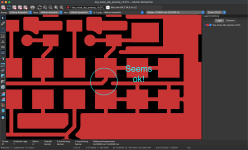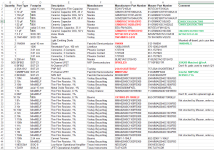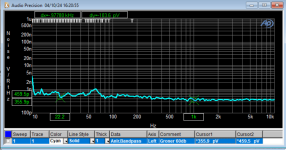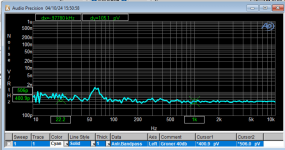Of course I also checked the right side, no flaw in the Gerbers there as far as I can tell.
Edit: I have also ordered from JLCPCB. Had some trouble getting the gerbers recognized elsewhere, partly due to the drill files, partly due to the fact that Altium apparently doesn't export the outline as a separate layer by default. That small error also shouldn't really matter, suppose during manufacturing that small copper bridge will end up wider than in the gerbers anyway, even if it wasn't fixed in the review process.
Edit: I have also ordered from JLCPCB. Had some trouble getting the gerbers recognized elsewhere, partly due to the drill files, partly due to the fact that Altium apparently doesn't export the outline as a separate layer by default. That small error also shouldn't really matter, suppose during manufacturing that small copper bridge will end up wider than in the gerbers anyway, even if it wasn't fixed in the review process.
Attachments
Hello folks,
I recently built this design, had the pcb’s fab’d at jlcpcb. I built up one of them, I had some bf862, so used them. I tested the assembly it works fine, need to install it in a enclosure to finish up the project. I have a Mouser shopping cart available. In the cart I sub’d 2sk3557, bought them graded them but never installed and tested them. Took a bit of time to find sub’s since some original parts spec’d by Sam are now no longer available.
I looked over the Gerber and saw those points you identify. They are a result of him doing copper pours and using a very small clearance. No problem for jlcpcb however.
Let me know if you need this info and I can post it for you.
I recently built this design, had the pcb’s fab’d at jlcpcb. I built up one of them, I had some bf862, so used them. I tested the assembly it works fine, need to install it in a enclosure to finish up the project. I have a Mouser shopping cart available. In the cart I sub’d 2sk3557, bought them graded them but never installed and tested them. Took a bit of time to find sub’s since some original parts spec’d by Sam are now no longer available.
I looked over the Gerber and saw those points you identify. They are a result of him doing copper pours and using a very small clearance. No problem for jlcpcb however.
Let me know if you need this info and I can post it for you.
2SK209 were spec'd for the Pass Pearl3 -- they should work reasonably well.
MMBF5462 is obsolete, but the Interfet SMP5462 is a close substitute. This JFET is used to bootstrap the reference voltage for the CCS, perhaps a switching JFET could substitute.
2SA1312 are obsolete, I will build the CCS with ZXTP2027F which is the SMT version of ZTX951 and report back.
I attach Groner's BOM (as jpeg) with the obsolete parts in red, the suggested replacements in green. Digikey has the MiniMelf resistors in stock.
MMBF5462 is obsolete, but the Interfet SMP5462 is a close substitute. This JFET is used to bootstrap the reference voltage for the CCS, perhaps a switching JFET could substitute.
2SA1312 are obsolete, I will build the CCS with ZXTP2027F which is the SMT version of ZTX951 and report back.
I attach Groner's BOM (as jpeg) with the obsolete parts in red, the suggested replacements in green. Digikey has the MiniMelf resistors in stock.
Attachments
Depends on what is being measured. For this instrument the frequency range of interest is 10Hz to 100kHz as stated by the designer.The real measurements for low feq. LNA starts below 10Hz or even lower 1Hz to any lower ends.
I do have an SR785! (The HP35670 is long gone)The real measurements for low feq. LNA starts below 10Hz or even lower 1Hz to any lower ends... and than
The gain of the Groner LNA with the lowest noise floor is 1050 or 60.4dB. Sam used MiniMelf 0402 resistors in his design, I used 0805 which I had on hand. Power derived from a 12V SLA stepped down to 8.5V to run Jan's "Silent Switcher". All contained in a large-ish cookie tin.
Settings are Analog Analyser, "Bandpass", Detector "RMS", Auto-Precise. The macro takes the analyser reading, divides by the square root of frequency. gain and bandpass filter factor to derive V/RtHz. There isn't a whole lot of difference between the analog analyzer and FFT when the latter uses the "FFT Scaling for Noise" macro
A 100mHz to 10Hz analysis for the amplifier isn't practical owing to the negative capacitance of the amplifier input (pointed out by Sam in his article) An increase of the value of C1 to 5.6uF puts a 3dB hump in the curve at 150mHz. Substituting 2.7uF for C101 (from 1uF) puts the -3dB @165mHz.
AP recommends 4 readings per second for noise measurement, but I found that the standard deviations below 100Hz were actually lower for "Auto-Precise" or "Auto".
AP recommends 4 readings per second for noise measurement, but I found that the standard deviations below 100Hz were actually lower for "Auto-Precise" or "Auto".
Probably about 1 ton. . . The problem is getting something to measure or solve a specific problem and not knowing when you will encounter it again. And not letting stuff go into trash, Like the HP VNA or the Tek Digital Signal Analyzer even though I don't have immedate use. Or a surge generator to test plug strips for UL or a tester for UPS's. Or two CLT-1 component linearity testers so I can check pots for distortion.
- Home
- Design & Build
- Equipment & Tools
- Groner's Low noise measurement amp from Linear Audio vol 3 - spare boards?



